2015 Ford F-150 vs. 2015 Chevy Silverado
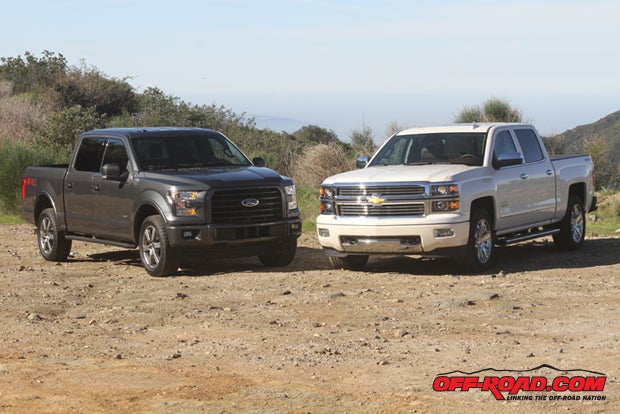
Ready. Aim. Fire!
Chevy offers a V6 and 5.3-liter V8 option in the Silverado, but our 2015 Silverado High Country 4WD Crew test truck is closer to the cream of the crop, and therefore this fully loaded truck is powered by the larger 6.2-liter V8 thatís mated to the new eight-speed automatic trans. Fordís 2015 F-150 4x4 Supercrew is also handsomely equipped, and it is powered by the F-150ís 3.5-liter V6 EcoBoost with a six-speed automatic transmission.
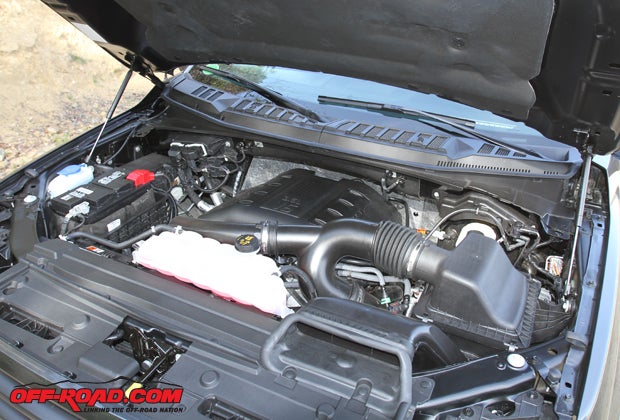
To get a truer sense of what these engines produce in terms of power, we headed over to Stillen in Costa Mesa, California. Founded nearly 30 years ago by former IMSA road racer Steve Millen, Stillen has covered the gamut by working on mini-trucks back in the Ď80s and now handling everything from tuner cars to supercharged full-sized trucks. Running on their outdoor dyno would give us some additional performance data on what these motors actually provide for rear-wheel horsepower. Helping us with the testing was shop manager Dave Alcavas, whoís been with the company for nearly two years but also worked with the shop in the early 2000s.
Fordís EcoBoost 3.5L V6 was first up. Fordís new flagship motor for the F-150 is rated to produce 365 hp at 5000 rpm and 420 lb.-ft. of torque at 2500 at the crankshaft. During our dyno runs at Stillen, it produced a peak horsepower rating of 296.27 and a max torque rating of 357.5 lb., which is within the roughly 25 percent expected loss once the power makes its way to the rear wheels.
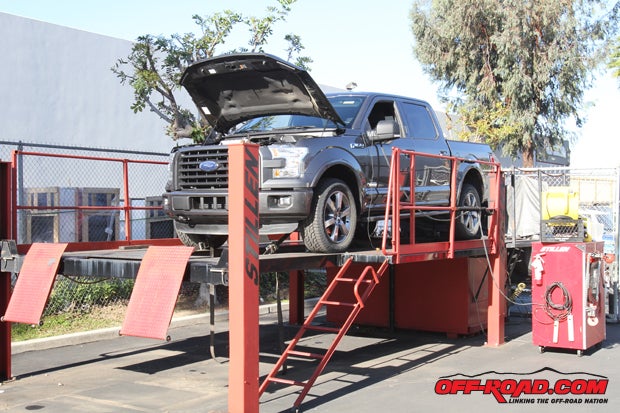
During our acceleration trials, the Ford produced a slower 0-60 mph time of 6.4 seconds versus 5.51 seconds from the Chevy, but it did seem to make up the ground in the midrange and top end by edging out the Chevy by the slimmest of margins on the 1/4-mile at 14.47 seconds at 96.44 mph compared to the Chevyís time of 14.48 at 98.58 mph.
Horsepower/Torque Testing
Ford F-150 3.5-liter V6 Ecoboost
Peak HP: 296.37
Max Torque: 357.5
Chevy Silverado 6.2-liter V8
Peak HP: 326.89
Max Torque: 345.20
As its 0-60 times attest the F-150 lacks some low-end power, as the V6 just doesnít get the assistance of the twin turbos quickly enough to provide substantial grunt at low rpm. Once the turbos spool up and the engine gets on the boost, however, it really roars to life. A common concern voiced about the turbocharged EcoBoost is whether it suffers from turbo lag, but our testers were pleasantly surprised this isnít an issue. ďThe EcoBoost engine is extremely smooth,Ē said contributing editor Scott Rousseau. ďTurbo-lag is nonexistent. What you do feel at times is a lack of displacement. Going from off boost to boost is a much more seamless transition than I expected it to be, and the throttle response and power remain crisp when you get in and out of the throttle when the engine is on boost.Ē
Our F-150 is equipped with the upgraded 3.55:1 gear ratio (3.15 or 3.31 are the other options), and while at cruising speeds of 65 mph on the highway the F-150 settled in right at about 1600-1700 rpm. The Chevy turned roughly the same 1600 rpm at 65 mph with its 3.42:1 rear axle ratio.
On the highway or wide-open trails where you can really get on the throttle, the 3.5L EcoBoost and six-speed transmission meld seamlessly to provide a great package. The smooth-shifting SelectShift six-speed transmission clicks through the gears nicely on the open road, but while testing on winding mountain roads we did note the transmission would want to downshift when the driver gets off the gas or on the gas. We think this is likely a product of Ford engineers wanting to keep the V6 motor in the optimum torque range at all times.
Overall we were happy with the performance of the 3.5L EcoBoost, but the lack of pep off the bottom is something traditional V8 fans may have a hard time adapting to. This is most identified by the F-150ís 0-60 time that was .89 seconds slower than the Chevy. It may not have the same brawny feel of bigger V8, but as the similar 1/4-mile times note, the Ford quickly made up the time it lost on the bottom. Itís a quick and powerful motor, but that power is delivered in a way that is different from what some might expect.
Speed Testing
Chevy Silverado
0-60: 5.51 seconds
1/4: 14.48 @ 98.58 mph
Ford F-150
0-60: 6.4 seconds
1/4: 14.47 @ 96.44
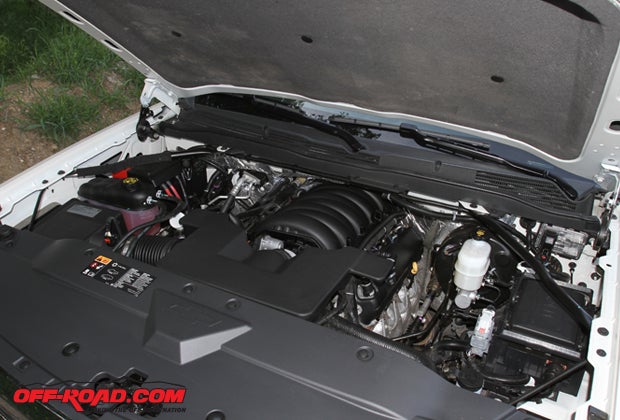
While Ford's goal is to achieve fuel efficiency with a smaller displacement V6 that provides the power when needed via dual turbo-chargers, Chevrolet goes the more traditional route by relying on a big 6.2-liter V8, albeit a modernized version designed to improve fuel economy via direct injection, variable valve timing, and cylinder deactivation technology that essentially turns the big V8 into a fuel-sipping V4 under light engine loads where big power isnít needed to keep the Silverado moving.
Chevy's 6.2L motor is claimed to produce 420 hp at 5600 rpm and 460 lb.-ft. of torque at 4100 rpm at the crankshaft. When hooked up to Stillenís dyno the Silverado produced a peak horsepower rating of 326.89. We were a little surprised to see the max torque lower than the Ford at 345.2 lb.-ft., but our dyno operator explained that part of the inconsistency was due to the fact that there was no way to keep the Chevy's transmission from shifting during the dyno runs, which throws off the reading. Therefore, we donít believe these test figures are entirely accurate for the Silverado, and as we noted, the governed speed also hampered its 1/4-mile time.
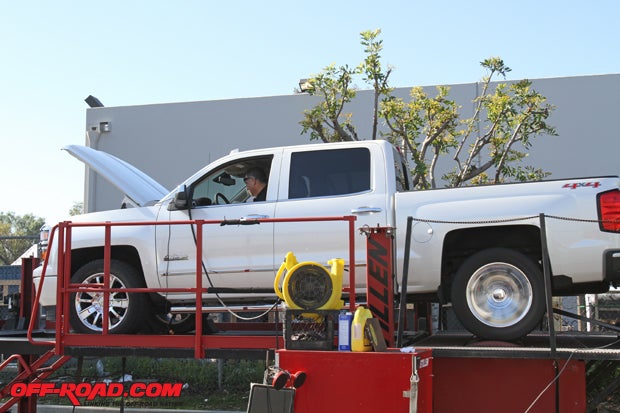
Our seat-of-the-pants feel during testing was that Chevy has the edge in low-end grunt, which is the domain of bigger V8 engines. Its sweet spot is the low-end to midrange, which is great for towing and when carrying heavy loads. We also noted the nice exhaust note on the Silverado, a hearty V8 rumble that nicely complements the feel of the engine.
Having recently tested a Silverado with the 5.3-liter V8 engine with six-speed transmission, we were impressed with the additional power produced from the 6.2-liter V8. The addition of the eight-speed trans wasnít as apparent as we expected, though. As Rousseau noted during testing, ďIf itís going through eight gear changes in a cycle, I had a hard time feeling them, which is a credit to its smooth shifting.Ē
Fuel Consumption
With even more stringent fuel economy regulations coming down the pipe in 2017 and í19, full-size truck makers are forced to address this issue. Clearly both of these trucks are looking to do so Ė Ford with a turbo V6, while Chevy updates its V8 technology.
Our Ford F-150 4x4 SuperCrew features an EPA rating of 17 mpg in the city and 23 mpg on the highway for a combined rating of 19 mpg with its 3.5L V6 EcoBoost. During testing, we observed a combined 18.7 mpg with the F-150, and for highway driving we measured our best fuel economy at 21.4 mpg. Our Chevy Silverado with the 6.2L V8 and eight-speed trans features an EPA rating of 15 mpg in the city and 21 mpg on the highway. During testing, our observed combined fuel economy was 17.2 mpg, which is slightly higher than the EPA combined rating of 17 mpg. One highway fuel economy test of the Silverado delivered our best reading at 19.1 mpg.


 Your Privacy Choices
Your Privacy Choices